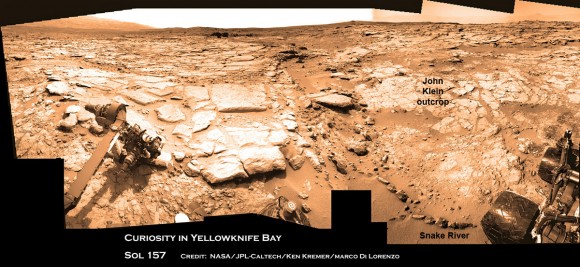

| Visitors Now: | |
| Total Visits: | |
| Total Stories: |

| Story Views | |
| Now: | |
| Last Hour: | |
| Last 24 Hours: | |
| Total: | |
Watery Science ‘Jackpot’ Discovered by Curiosity
Curiosity found widespread evidence for flowing water in the highly diverse, rocky scenery shown in this photo mosaic from the edge of Yellowknife Bay on Sol 157 (Jan 14, 2012). The rover will soon conduct 1st Martian rock drilling operation at flat, light toned rocks at the outcrop called “John Klein”, at center. ‘John Klein’ drill site and ‘Sheep Bed’ outcrop ledges to right of rover arm are filled with numerous mineral veins and spherical concretions which strongly suggest precipitation of minerals from liquid water. ‘Snake River’ rock formation is the linear chain of rocks protruding up from the Martian sand near rover wheel. Credit: NASA/JPL-Caltech/Ken Kremer/Marco Di Lorenzo
The Curiosity rover hit the science “jackpot” and has discovered widespread further evidence of multiple episodes of liquid water flowing over ancient Mars billions of years ago when the planet was warmer and wetter, scientists announced. The watery evidence comes in the form of water bearing mineral veins, cross-bedded layering, nodules and spherical sedimentary concretions.
Any day now the robot will be instructed to drill directly into veined rocks where water once flowed, the team announced at a media briefing this week.
Delighted researchers said Curiosity surprisingly found lots of evidence for light-toned chains of linear mineral veins inside fractured rocks littering the highly diverse Martian terrain – using her array of ten state-of-the-art science instruments. (…)
Read the rest of Watery Science ‘Jackpot’ Discovered by Curiosity (1,678 words)
© Ken Kremer for Universe Today, 2013. | Permalink | No comment |
Post tags: Curiosity, Curiosity Rover, Mars, Mars Rovers, Mars Science Laboratory (MSL), MSL, NASA
Feed enhanced by Better Feed from Ozh
2013-01-18 20:31:12
Source: http://www.universetoday.com/99439/watery-science-jackpot-discovered-by-curiosity/
Source:



